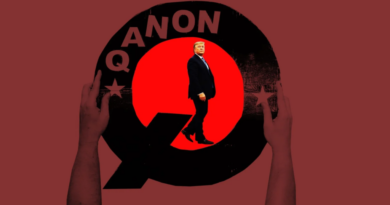What Teachers Should Do When QAnon Conspiracy Theories Come to Class

Teachers have long had to decide whether to give conspiracy theories that students bring up any airtime in class. But a set of far-right theories known as QAnon has made those decisions even more difficult.
The New York Times defines QAnon as “the umbrella term for a sprawling set of internet conspiracy theories that allege, falsely, that the world is run by a cabal of Satan-worshipping pedophiles who are plotting against [President Donald] Trump while operating a global child sex-trafficking ring.”
The conspiracy, which has been called a domestic terrorist threat by the FBI, has gotten more media attention recently, as one of its supporters, Marjorie Taylor Greene, won a U.S. House seat in Georgia this week. Some of the theories have spread on TikTok (which is cracking down on QAnon-related content) and Instagram, where students might stumble across them.
Two-thirds of educators say they have either never heard of QAnon or don’t know enough to have an opinion, according to a nationally representative survey, administered online Oct. 28-29 by the EdWeek Research Center. A total of 1,630 educators responded, including 495 district leaders, 310 principals, and 825 teachers.
Thirty-one percent said QAnon theories are “completely untrue,” with 1 percent saying they’re “somewhat untrue.” Just 3 percent said the theories are “somewhat” or “completely” true.
“A growing number of people have heard of QAnon, but most of them don’t really know what it is,” said Adam Enders, an assistant professor of political science at the University of Louisville in Kentucky who studies conspiracy theories. “To be fair, who really knows? It’s sort of like a mega-conspiracy that’s swallowed a whole bunch of conspiracy theories. It’s everything, and nothing.”
Most students, he said, probably don’t know what it is. A September Pew Research Center survey found that young adults (age 18 to 29) are no more likely than other age groups to have heard about QAnon. However, among those who have heard about the conspiracy theories, young adults are the most likely to say it is a good thing, the Pew survey found—29 percent compared with 20 percent or less of any other age groups.
Educators are torn on whether they should address the theories in the classroom in an attempt to stomp out the misinformation, EdWeek survey results show.
Of the educators who are aware of QAnon, one-third say they favor teaching students what it is and that its theories are untrue, but only if students bring it up. Just 9 percent say teachers should do that even if students don’t bring it up. About one-fifth think it should be ignored altogether, even if students talk about it in class.
In open-ended survey responses, some teachers say they aren’t allowed to discuss controversial or political issues in class. Also, the subject matter of many QAnon theories—like pedophilia and sex-trafficking—is uncomfortable to discuss in the classroom and inappropriate for younger students.
The EdWeek survey found that 19 percent of educators believe teachers should explain what QAnon is and then offer evidence for and against its theories. But Enders cautioned against a “both sides” approach. While he can explain how people might believe some of the theories, he doesn’t think it would be helpful to share that nuance with students.
“I think that would end up arming them with [what they see as] evidence,” he said.
Asking for Evidence
A recent Buzzfeed News article reported that when high school students buy into QAnon theories, it can become a daunting task for teachers to debunk them.
“For the teachers I spoke to, explaining actual facts to misguided students can seem nearly impossible,” reporter Scaachi Koul wrote. “In response, their students simply say that the news media is biased, and that Donald Trump is sending subtle signals to QAnon believers about how he’s on the brink of saving the world from pedophile rings.”
Instead of teachers trying to disprove a set of convoluted theories, Enders said a better approach might be teaching students how to spot misinformation. One recent study found that students are not well-equipped to judge information for its accuracy, relevance, and quality. However, past research has found that simple interventions—like tips on how to discern real news from false information—can increase students’ ability to weed out fake news.
Chris Dier, a high school U.S. history teacher in New Orleans and the 2020 Louisiana Teacher of the Year, had a student bring up QAnon this year. Dier gave a brief explanation, and his students seemed to quickly dismiss the theories as false.
But if he did have a student who believed QAnon theories were true, Dier said he would use it as an opportunity to push for sources and evidence, which is already a staple of his classroom. He also might talk to the student about it one-on-one, instead of spending a lot of class time on conspiracy theories.
“I would never dismiss their concerns—their views are just as legitimate to them as ours are to us,” he said. “I think I would have them dissect the [theories] and demand evidence.”
For instance, Dier said he once had a student who believed the earth was flat: “Once we presented the evidence, she stopped believing it.”
Image: kasezo/iStock/Getty Images Plus
*** This article has been archived for your research. The original version from Education Week can be found here ***


